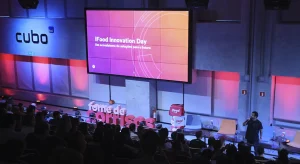One of the pillars of iFood's culture is the innovation, driven by our teams' ability to reinvent themselves in an agile way, which allows us to test new ideas and react quickly to the changes that surround us. This is a value in all areas of the company and would be no different in our Jet Skis teams, the minds behind disruptive innovation.
Jet Skis are temporary teams whose mission is to put ideas to the test. They are lean, multidisciplinary teams that are not afraid to take risks and “break walls”. They are the ones who select the most innovative ideas that emerge in the company and, from there, develop a pilot project for around two months.
Those squads They are made up of people from business, design, technology and products – all gathered to discover what iFood's next big bet on innovation will be. They could even work on improving features, as many technology companies do, but we prefer to take advantage of the speed of these teams to test larger theses, which are not on the core team's radar.
Some of these projects will emerge as strong competitors and will become “speed boats”, with the pilot able to be expanded and implemented. Others may sink when colliding with an iceberg – or we simply learn that the mission concept is not suitable for the transatlantic ship.
In Jet Ski teams, the culture is to challenge the company's status quo and explore new frontiers so that iFood can navigate new seas, always thinking outside the box and putting ideas into practice, because these teams breathe execution. It is a team that is looking at radical, not incremental, innovation. And for what no one has yet dared to do. This is what moves the entire company in new directions.
Jet Ski principles are continually refined and expanded as we learn new lessons along the way, and its methodology is based on the following pillars:
1. Focus on strategic ideas
Everyone has an idea that can improve the business. But is it aligned with the strategic goals for the company? If not, moving this project forward could prove to be a huge waste of personal and financial resources, as the team will be chasing goals that have little to do with the strategic work that must be done.
To prevent this from happening, the first guiding principle of the Jet Ski methodology is: each mission must be aligned with the strategic objectives of the business. Executive teams must sift through incoming ideas and focus on those that have the best chance of accelerating the mothership so that it flies faster.
2. Choose those who like risk
When choosing who will be part of the Jet Ski teams, we highly value the people we call “finishing”, that is, those who have an entrepreneurial spirit, resilience and energy to put ideas into practice.
Furthermore, managers select flexible professionals who feel comfortable taking risks. To choose the most daring ones, we have a psychological test, the Myers Briggs MBTI Test. Those who score high on Scale N like uncertainty and thrive in this scenario, that is, they have a firm basis for innovating and exercising leadership that inspires others.
3. Done is better than perfect
For us, the done is better than the perfect, hence the freedom we have to improvise, test, make mistakes and learn. If there's an expression that we love, it's “we love gambiarra”. Jet Ski teams operate within an operating principle based on the concept we call “breaking the walls”: they have the green light to apply maximum pressure to the “plumbing” and it’s okay if they burst.
We can rest assured if everything goes wrong because iFood limits the impact of experimentation, which takes place in a controlled environment so as not to affect the corporate ecosystem. In the end, the Jet Ski lessons are taken back to the larger team on board the liner.
4. Operate in short cycles
Don't expect Jet Skis to deliver the perfect solution right away (in fact, it's okay to not know if the new approach will work). What we've discovered from our experience is that it's best to develop the simplest solutions, test them, gain insights and move on quickly.
Jet Ski teams are inherently fast and work with rapid tests, in very short cycles. Each cycle, we regroup with them to discuss discoveries, key learnings, and next steps in the mission. Thus, the senior executives in charge of overseeing Jet Ski receive a complete report and help define its direction and mission for the next 15 days.
5. Create multidisciplinary teams
Jet Skis are made up of people from different backgrounds and functions who are completely dedicated. At iFood, this team is generally made up of people specializing in business, product, engineering, data and AI (artificial intelligence). They work together for three to six months to discover whether the mission is viable and adds value to the organization's long-term vision and strategy.
For more Jet Skis to be successful and have the opportunity to become speed boats, they need technological support with each new season. In this way, the squads can guide the IT team, for example, to make adjustments to the iFood application, execute data analysis, provide agile software development or in-depth AI expertise.
How about innovating even further with data analysis?
Available to free download, the e-book Data analysis in business: a step by step towards a data driven culture


